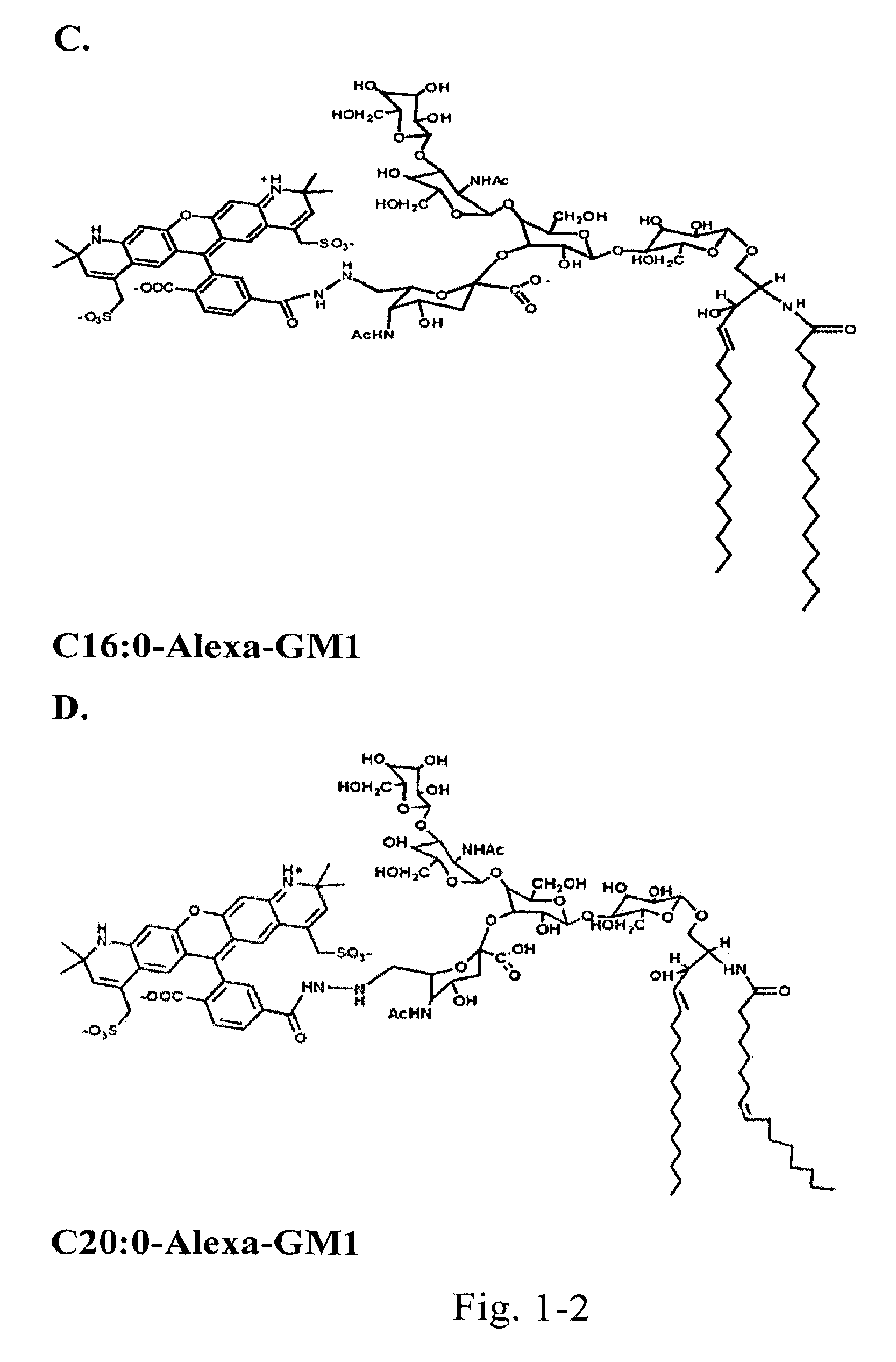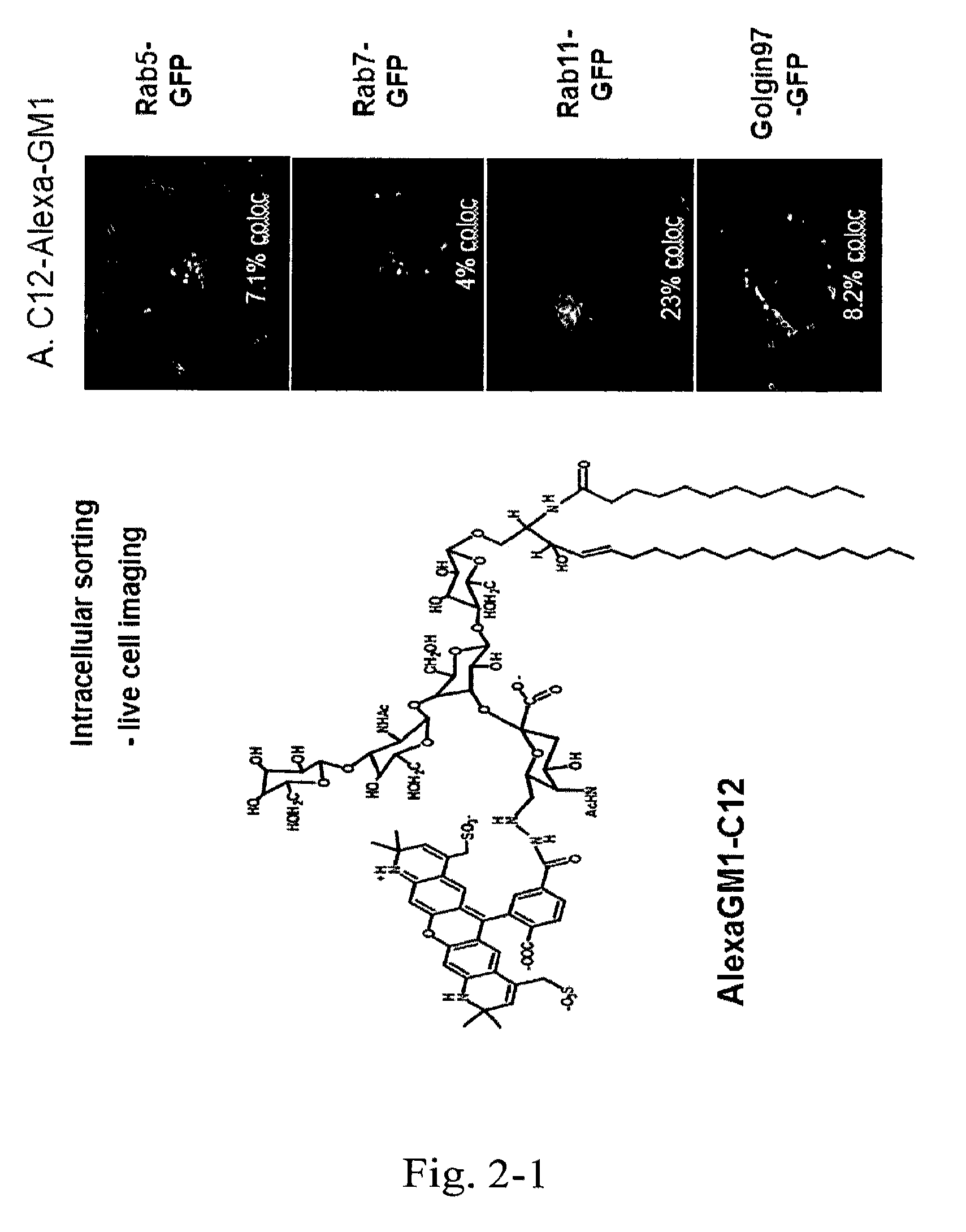Mucosal delivery of therapeutic molecules, proteins, or particles coupled to ceramide lipids
a technology of ceramide lipid and mucosal delivery, which is applied in the direction of peptides, drug compositions, metabolic disorders, etc., can solve the problems of drug permeability and half-life, and limit the development of new therapeutics
- Summary
- Abstract
- Description
- Claims
- Application Information
AI Technical Summary
Benefits of technology
Problems solved by technology
Method used
Image
Examples
example 1
[0121]The fluorescently-labeled GM1 isoforms were applied to apical membranes of polarized epithelial cells at a concentration of 1.6 μM in Hank's Buffered Saline Solution (HBSS) with 0.034% defatted bovine serum albium (BSA) at 10 C for 1 hour. After washing away unincorporated GM1 from the apical membrane with cold HBSS, the cells were incubated at 37° C. for 90 minutes and then imaged by spinning disk confocal microscopy. The data shows that only the C12 isoform loads the basolateral membranes. The C18 isoform does not label the basolateral membranes and goes to late endosomes only as shown by concentrated puncta in non-polarized cells. (FIGS. 6-10).
example 2
Construction of Ganglioside-Peptide Complex
[0122]Chemically couple a small “reporter” peptide GKSKG-YPYDVPDYA(HA-tag)-GKSGC to the oligosaccharide head group of ganglioside GM1 containing ceramides with C12:0, C16:1, or C18:0 fatty acids.
[0123]The chemistry for this is by use of a maleimide-hydrazide cross-linker to couple the peptide at its C-terminus to an aldehyde generated in glycerol chain in the sialic acid of the GM1 oligosaccharide by periodate oxidation. The ceramide isoforms are synthesized starting with lyso-GM1 and linking fatty acids of defined structure to the free amine by activation of the fatty acid carboxyl group with dicyclohexylcarbodiimide (DCC) or 1-ethyl-3-(3-dimethylaminopropyl)-carbodiimide (EDC) followed by addition of either N-hydroxysulfosuccinimide (sulfo-NHS) or N-hydroxysuccinimide (NHS) in dimethylsulfoxide (DMSO). Purification is by reverse phase and ion-exchange chromatography FPLC followed by structural confirmation with mass spectroscopy. Lipids s...
example 3
Assessment In Vitro
[0124]The novel lipo-peptides prepared above are tested for transcellular transport across cultured polarized epithelial cell barriers in vitro; and for differential trafficking into the recycling or late endosomal / lysosome pathway in non-polarized cells. Only the short chain C12:0 and unsaturated C16:1 ceramides carry the peptide into the transcytotic pathway and away from the lysosome.
[0125]The lipo-peptides are introduced to the apical or basolateral membrane of polarized intestinal cells in monolayer culture at 10° C. After subsequent incubation at 37° C., transcytosis is assayed biochemically by selective cell surface biotinylation (the reporter molecule carries free amines providing the reactive group for coupling to biotin) and morphologically by confocal microscopy after fixation and immunostaining for the HA-tag also contained in the reporter peptide.
[0126]The control for non-specific paracellular transport is by clamping vesicular traffic in the monolaye...
PUM
| Property | Measurement | Unit |
|---|---|---|
| time | aaaaa | aaaaa |
| permeability | aaaaa | aaaaa |
| structure | aaaaa | aaaaa |
Abstract
Description
Claims
Application Information
 Login to View More
Login to View More - R&D
- Intellectual Property
- Life Sciences
- Materials
- Tech Scout
- Unparalleled Data Quality
- Higher Quality Content
- 60% Fewer Hallucinations
Browse by: Latest US Patents, China's latest patents, Technical Efficacy Thesaurus, Application Domain, Technology Topic, Popular Technical Reports.
© 2025 PatSnap. All rights reserved.Legal|Privacy policy|Modern Slavery Act Transparency Statement|Sitemap|About US| Contact US: help@patsnap.com



